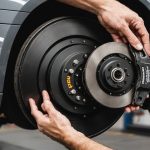Installing a tow bar on your British estate car can enhance its utility, but concerns about warranty implications often deter enthusiasts. This guide demystifies the installation process, offering clear step-by-step instructions that maintain warranty compliance. Explore practical tips and essential considerations to ensure a seamless installation. With the right approach, you'll be able to enjoy the added functionality of a tow bar while safeguarding your vehicle's guarantees. Let’s unlock the potential of your estate car together!
Understanding Tow Bar Installation
When considering tow bar installation for your British estate car, it's vital to understand their purpose and the implications for your vehicle warranty. Tow bars are essential for safely towing trailers, caravans, or other vehicles, making them a practical addition for many car owners. However, installing a tow bar isn't just about bolting a device onto your car. It requires careful consideration to ensure it aligns with your vehicle's specifications and warranty guidelines.
Also to read : Revamp Your British Family Sedan: Step-by-Step Guide to Adding Stylish Modern LED Interior Lighting
Adhering to these guidelines is crucial, as improper installation can void your vehicle warranty. Manufacturers often specify how modifications should be carried out to maintain the car's integrity and safety features. Failing to follow these instructions can lead to costly repairs that aren't covered by your warranty.
There are common misconceptions about vehicle modifications, such as the belief that all tow bars are universal. In reality, tow bars must be compatible with your specific vehicle model to function correctly and safely. Additionally, some owners mistakenly assume that any modification automatically voids their warranty. While modifications can impact warranty coverage, following manufacturer guidelines and using approved parts can help preserve it. Understanding these nuances ensures a smooth and compliant tow bar installation process.
Also to read : Mastering Adaptive Cruise Control: Enhancing Safety in Your British Luxury Sedan
Necessary Tools and Materials
Before embarking on a tow bar installation, ensuring you have the right tools and materials is crucial. This not only simplifies the process but also ensures safety and efficiency.
Essential Tools for Installation
- Socket Wrench Set: Vital for tightening bolts securely.
- Torque Wrench: Ensures bolts are tightened to the specified torque, maintaining safety standards.
- Drill and Bits: Necessary for creating precise holes if required.
- Screwdrivers: A set of both flathead and Phillips screwdrivers for various screws.
- Measuring Tape: Ensures accurate alignment and placement.
Recommended Materials and Parts
- Tow Bar Kit: Includes the bar, brackets, and necessary hardware.
- Wiring Harness: Essential for connecting the tow bar's electrical components.
- Rust-Proofing Spray: Protects metal parts from corrosion.
Sourcing Quality Tools and Materials
Quality is paramount when selecting DIY tools and installation materials. Reputable automotive stores and online platforms offer a range of products. Look for brands with positive reviews and warranties. Investing in high-quality tools not only aids in a successful installation but also serves future projects.
Preparation for Installation
Before diving into the tow bar installation, proper installation preparation is essential to ensure a smooth and safe process.
Steps for Preparing the Vehicle
Begin by thoroughly cleaning the area where the tow bar will be attached. This helps in identifying any existing damage or rust. Next, gather all necessary tools and materials, ensuring they are within easy reach. This reduces the risk of interruptions during the installation process.
Safety Precautions
Safety should be a top priority. Wear protective gear such as gloves and safety glasses to prevent injuries. Ensure the vehicle is on a stable, flat surface and securely parked with the handbrake engaged. Disconnect the battery to avoid any electrical hazards. These safety precautions help mitigate risks associated with the installation process.
Importance of Vehicle Inspection Pre-Installation
Conducting a comprehensive vehicle inspection before installation is crucial. Check for any pre-existing issues, such as rust or damage, that could compromise the installation. Verify that the vehicle's frame is in good condition and capable of supporting the tow bar. Addressing these concerns beforehand ensures a secure and compliant installation, safeguarding both the vehicle and its warranty.
Step-by-Step Installation Guide
Embarking on a DIY tow bar installation requires a structured approach to ensure success and safety. Follow these detailed steps to navigate the installation process effectively.
Removing Vehicle Components
Begin by carefully removing the vehicle's bumper and any underbody panels that might obstruct access to the mounting points. Use a socket wrench set to detach bolts and clips, storing them safely for reassembly. It's crucial to handle all components gently to avoid damage.
Installing the Tow Bar
Position the tow bar according to your vehicle's specifications. Align it with the pre-drilled holes and secure it using the provided hardware. Employ a torque wrench to tighten bolts to the recommended torque, ensuring stability and safety. If necessary, drill additional holes using a drill and bits for a precise fit.
Reassembling the Vehicle
Once the tow bar is securely mounted, begin reattaching the removed components. Ensure all bolts and clips are returned to their original positions. Double-check the alignment and fit of the bumper and panels. Finally, reconnect the wiring harness, ensuring all electrical connections are secure and functional. This meticulous reassembly process ensures your vehicle remains in optimal condition post-installation.
Compliance with Warranty Regulations
Understanding warranty compliance is essential when making vehicle modifications like installing a tow bar. Your warranty terms often specify how modifications should be performed to avoid voiding coverage. Carefully review your vehicle's warranty documents to understand the conditions and limitations regarding modifications. This will help ensure that your tow bar installation adheres to the manufacturer's requirements.
Documenting the installation process is vital for maintaining warranty validity. Keep a detailed record of the installation, including photographs, receipts for parts, and any professional services used. This documentation can serve as evidence that the modification was completed according to the manufacturer's guidelines.
To further ensure warranty compliance, consider the following tips:
- Use only approved parts and accessories specified by the vehicle manufacturer.
- Follow the installation instructions meticulously, as outlined in the tow bar kit and vehicle manual.
- If uncertain about any step, consult a professional installer to avoid any errors that might affect your warranty.
By understanding your warranty terms and carefully documenting the installation, you can confidently proceed with vehicle modifications while preserving your warranty coverage.
Maintenance and Safety Checks
Regular tow bar maintenance and safety checks are crucial for ensuring both functionality and vehicle care. Routine inspections help identify potential issues before they escalate into major problems.
Routine Checks
Conducting routine safety checks involves examining the tow bar for signs of wear and tear, such as rust or loose bolts. Check the wiring harness for any frayed wires or poor connections, as these can affect the tow bar's electrical components. Regularly ensure that the tow bar is securely attached and that all bolts are tightened to the correct torque specifications.
Recommended Maintenance Practices
To prolong the life of your tow bar, apply a rust-proofing spray periodically to protect it from corrosion. Clean the tow bar and its components regularly to remove dirt and debris that can cause damage over time. Lubricate moving parts as needed to maintain smooth operation.
Signs of Wear
Be alert for signs of wear, such as unusual noises or difficulty in attaching or detaching the tow bar. If you notice any damage or if the tow bar does not perform as expected, seek professional assistance promptly. Addressing issues early can prevent more extensive repairs and ensure your vehicle's safety.
Frequently Asked Questions
When considering a tow bar installation, many vehicle owners have questions about warranty implications and legal aspects. Understanding these can help ensure a smooth process.
Common Warranty Questions
Will installing a tow bar void my warranty? Not necessarily. If you use approved parts and follow the manufacturer's guidelines, your warranty should remain intact. Document the installation process thoroughly to safeguard your warranty.
Legal Aspects in the UK
Are there legal requirements for tow bars in the UK? Yes, tow bars must comply with UK safety standards. They should be type-approved and suitable for your specific vehicle model. Ensure your tow bar and installation meet these criteria to avoid legal issues.
Installation Concerns and Troubleshooting
What if I encounter problems during installation? Consult your vehicle's manual and the tow bar kit instructions. If issues persist, seeking professional assistance can prevent errors and potential warranty violations. Regularly inspect the tow bar post-installation for any signs of wear or improper fitting. Addressing concerns early can prevent further complications.
















